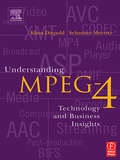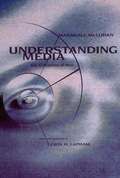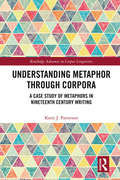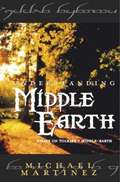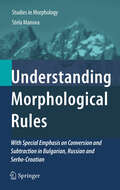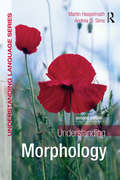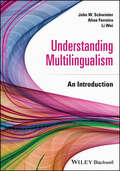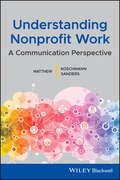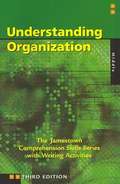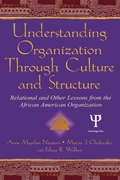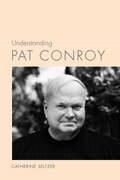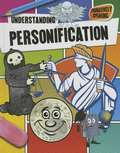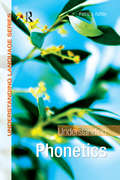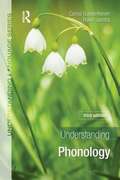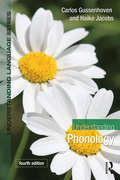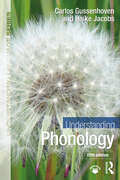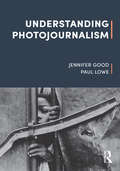- Table View
- List View
Understanding Literacy Development: A Global View
by Linda M. Phillips Anne McKeough Vianne Timmons Judy Lee LupartThe acquisition and maintenance of literacy is of pressing interest and concern to educators and educational policy makers worldwide. What are the common themes, the common questions, and the unique circumstances and initiatives that spring from this interest and concern? To address these questions, Understanding Literacy Development: A Global View brings together leading experts from around the world to explore ways to best provide teaching and learning opportunities, tailored to specific educational needs, to help all children become better readers.The premise is that current generic "one-size-fits-all" approaches are inappropriate for many children and can lead to underachievement and failure. The contributors write from a stance that reflects not only their own particular expertise and experience, but also sheds light on literacy development across cultures, countries, and circumstances. Taken together, chapters in this volume target a wide and comprehensive set of literacy issues, and offer an extensive exploration of the complexities of literacy development, including issues related to early literacy, school instruction, family literacy, adolescent and adult literacy, and teacher development.At a time when education is burdened by increasing economic pressure to do more with less, it is imperative that educators and decision makers at all levels have access to current, broad-ranging, and in-depth information and evidence to inform their choices. This volume, compiling critical research on a wide spectrum of literacy concerns, is an invaluable tool for scholars, teacher educators, professionals and graduate students in the fields of literacy education, early childhood education, educational psychology, educational policy, and related areas.
Understanding Literature
by Macmillan Mcgraw-HillThe stories in the book are grouped according to some of the basic elements that an author works with when writing a story: plot, character, setting, point of view, and theme. The last group of stories illustrates the total effect achieved from skillfully varying and intermingling these basic ingredients. These elements contain the key to approaching any story with deeper understanding and greater pleasure.
Understanding Literature: A Survey of Fiction
by Janet M. DavisA Survey of Fiction Excerpts from the classics are used to teach skills such as character development, setting, plot structure, and conflict/resolution. Students learn to appreciate literature more fully and independently. Reading and Writing Nonfiction Students learn about various forms of nonfiction writing, first by reading and then writing. Explores several essay formats: Informative, Classification, Analogy, Descriptive, Autobiographical/Biographical, Anecdotal, Logical Argument, and Emotional Appeal.
Understanding MPEG 4: Technology and Business Insights
by Sebastian Moeritz Klaus DiepoldThe Practical Guide to MPEG 4 offers an up to date introduction to this important interactive and multimedia compression standard (including MPEG-4 Part 10), with real examples and information as to how and where this new technology should be used. All aspects of MPEG-4 that are relevant in today's technical landscape are described in this book, including video and audio creation, production, distribution, reception and consumption environment. This book explains everything you really need to know in jargon-free language: interactive systems, content management, deployment, licensing and business models.
Understanding Media in the Digital Age: Connections for Communication, Society, and Culture
by Everette E. Dennis Melvin L. DefleurThe book shows readers how to navigate the world of traditional and new media while fostering an understanding of mass communication theory, history, active research findings, and professional experience.
Understanding Media: The Extensions of Man
by Marshall McluhanIn a new introduction to this edition of Understanding Media, Harper's editor Lewis Lapham reevaluates McLuhan's work in the light of the technological as well as the political and social changes that have occurred in the last part of this century.
Understanding Metaphor through Corpora: A Case Study of Metaphors in Nineteenth Century Writing (Routledge Advances in Corpus Linguistics)
by Katie PattersonThis book introduces a unique methodology to the study of metaphor, integrating a corpus linguistic approach to explore the lexical, grammatical, semantic, and pragmatic characteristics of metaphoric instances of language. The volume questions the reliability of attempts to identify metaphor based on dichotomy and, drawing on data from a corpus of nineteenth-century writing, instead advocates for the notion that metaphoricity is context-dependent and fluid, in relation to the respective social and discourse contexts in which metaphors can be found. The book also applies Lexical Priming Theory to metaphoric language to suggest that our use of metaphor is due to unconscious behaviors, a counterpoint to perspectives that see metaphor use as part of the creative process. Taken as a whole, the volume calls for a deeper investigation of the complex web of meaning senses that contributes to our understanding of metaphor, making this key reading for students and researchers in corpus linguistics, metaphor studies, lexicography, semantics, and pragmatics.
Understanding Middle Earth: Essays on Tolkien's Middle-Earth
by Michael MartinezMichael Martinez calls himself a populist commentator. He has long been an advocate for fans of science fiction honing his encyclopedic knowledge of all of the works of J. R. R. Tolkien with Tolkien special interest groups on the internet, arranging Tolkien programming at fan run science fiction and fantasy conventions and making live, sophisticated presentations to audiences world wide. His coverage of Tolkien Topics in this collection of 36 essays is so thorough that you will feel as if Martinez has left no stone on Middle-earth unturned. He explains how the first elves lost their innocence taking their first step on a long road, filled with loss and grief, toward sorrow. He describes what they lost on their 500 year journey across a frozen wasteland and how Melkor's lies transformed artists who celebrated beauty to avaricious, vengeful, murdering, hoarders. He outlines the long lives of some of our favorite Elves including Gil-galad, Glorfindel and Legolas. He explains how the roles of elves changed through the long ages. For example, Elrond evolved from a warrior to an innkeeper. Exuberant, benevolent yet powerful Tom Bombadil is beloved by most Tolkien readers. Martinez illustrates Bombadil's importance to The Lord of the Rings and makes a strong case that it is a mistake to underrate him or pass him over as nonessential to the plot. We learn that only a few elves were vegetarians and that limbas is much like our cornbread though the corn used by the elves was a special, magical variety. Most of Tolkien's evil characters paid dearly for their deviation from goodness. In one essay Martinez explains why unlike other villains, Frodo is forgiven for crumbling and claiming the ring as his own instead of casting it in to the fire. This long book answers many of your questions about Tolkien's writing and stimulates further thought and debate on Tolkien's complex fantasy. Whether you read it all or skip to the essays that interest you, time spent reading this fascinating, well grounded book will enrich your Tolkien experience. A list of accented words with a key identifying the specific accents is provided on pages III and IV.
Understanding Minimalism
by Jairo Nunes Norbert Hornstein Kleanthes K. GrohmannMinimalist models of grammar are developed logically in this volume and the ways in which they contrast with GB analysis are clearly explained. Spanning a decade of minimalist thinking, the textbook will enable students to better understand the questions and problems that minimalism invites, and to master the techniques of minimalist analysis. Over 100 exercises are provided, encouraging students to put their new skills into practice. The book will be an invaluable text for intermediate and advanced students of syntactic theory, as well as a solid foundation for further study and research within Chomsky's minimalist framework.
Understanding Misunderstandings: A Practical Guide to More Successful Human Interaction
by Robert L. YoungHave you ever meant one thing, but said another? Reacted angrily when no offense was intended? Wished that the earth would open up and swallow you? Understanding Misunderstandings will help you get out and stay out of these difficulties. Robert L. Young explains why many common types of misunderstandings arise and how they can be avoided or corrected. In the first part of the book, he breaks the process of misunderstanding down into stages, showing how it can occur when we misspeak, mishear, misinterpret, or react in inappropriate ways. In the second part, he expertly analyzes the kinds of misunderstandings that can arise from differences in culture, social class, race and ethnicity, and gender. Real-life examples illustrate many of the problems and solutions he describes. Because misunderstanding can destroy friendships and marriages, wreck careers, and lead to clashes between whole segments of society, understanding and diffusing it is of the utmost importance. This reader-friendly book provides the practical guidance to do just that. Educators, business people, psychologists, parents-in fact, everyone who interacts with other people-will benefit from it.
Understanding Morphological Rules
by Stela ManovaThis volume analyzes morphological and morphonological phenomena from a number of distinct Slavic languages. It does so in an innovative manner, yet also positions the analysis in the context of current morphological debates. It is thus a valuable contribution both to comparative Slavic morphology and general morphological theory. Moreover, the book is the first attempt at a theory of conversion and subtraction relevant to languages with rich inflectional morphology. It contributes to our structural understanding of the nature of word. As the first illustration of subtraction with examples from southern Slavic languages, it is an excellent source of specialist data. The book's theoretical framework is easily accessible and applicable to other languages, which makes it attractive to researchers on Slavic languages and general linguists alike. The volume will also appeal to general morphologists, typologists, and advanced students in linguistics.
Understanding Morphology (Understanding Language)
by Martin Haspelmath Andrea SimsThis new edition of Understanding Morphology has been fully revised in line with the latest research. It now includes 'big picture' questions to highlight central themes in morphology, as well as research exercises for each chapter. Understanding Morphology presents an introduction to the study of word structure that starts at the very beginning. Assuming no knowledge of the field of morphology on the part of the reader, the book presents a broad range of morphological phenomena from a wide variety of languages. Starting with the core areas of inflection and derivation, the book presents the interfaces between morphology and syntax and between morphology and phonology. The synchronic study of word structure is covered, as are the phenomena of diachronic change, such as analogy and grammaticalization. Theories are presented clearly in accessible language with the main purpose of shedding light on the data, rather than as a goal in themselves. The authors consistently draw on the best research available, thus utilizing and discussing both functionalist and generative theoretical approaches. Each chapter includes a summary, suggestions for further reading, and exercises. As such this is the ideal book for both beginning students of linguistics, or anyone in a related discipline looking for a first introduction to morphology.
Understanding Multilingualism: An Introduction
by Li Wei John W. Schwieter Aline FerreiraIncluding detailed discussions of both the current state and future directions of the field, this comprehensive textbook presents a complete overview of multilingualism. Written by internationally recognized researchers and educators, Understanding Multilingualism: An Introduction provides detailed coverage of the various dimensions of modern multilingualism. It highlights the interdisciplinary nature of the field by exploring the broad spectrum of different sociolinguistic, psycholinguistic, and neurocognitive approaches to the study of multilingualism. The text begins by defining and clarifying the scope of multilingualism studies as a distinctive, interdisciplinary field of inquiry. Subsequent chapters discuss the historical development and theoretical models of multilingualism, how the brain processes multiple languages, the effect of multilingualism on human cognition, how multilingual processing changes over the human lifespan, societal management of multilingualism, multilingual education, and impact of technological advancement on multilingualism. The book concludes by addressing the prospect of a post-multilingual world and methodological issues in studying multilingualism. Considers the cognitive and linguistic implications of multilingualism to applied linguistics and language acquisition Examines the connections between multilingualism and changing socio-political and economic landscapes Reviews modern theories, methods, and research findings in multilingualism studies Discusses complex topics at both the individual and societal level Features numerous exercises, discussion questions, assignments, further readings, suggested research topics, and real-life case studiesUnderstanding Multilingualism: An Introduction is the perfect primary textbook for undergraduate courses in multilingualism and bilingualism, and an excellent resource for advanced students in applied linguistics, sociolinguistics, psycholinguistics, second language acquisition, and foreign language education programs.
Understanding Nonprofit Work: A Communication Perspective
by Matthew L. Sanders Matthew A. KoschmannOffers a valuable resource for scholars, teachers, students, and nonprofit practitioners interested in understanding nonprofit work from a communication perspective This sophisticated yet accessible book explores the dynamics of organizational communication in the context of nonprofit work. It delves deeply into the subjects of communication and social construction and develops several key subject areas and issues including leadership, management, and governance; the marketization of nonprofit work; collaboration and organizational partnerships; meaningful labor; and international nonprofit work. Understanding Nonprofit Work: A Communication Perspective is the first resource to bring together the considerable and voluminous amount of communication scholarship and nonprofit research available in academia. Moving beyond the simplistic notion of communication as merely the transmission of information, it instead develops a more insightful approach to nonprofit work based on the concept of communication as social construction, explaining the implications and applications of this distinct communication perspective in ways that will benefit both communication scholars and nonprofit practitioners. Additionally, this book: Brings together a wealth of information in communication theory and nonprofit organizations in a thoughtful, approachable style Demonstrates the application and utility of a communication perspective across several key aspects of nonprofit work Written by two well-known scholars in the field with considerable experience in nonprofit work—teaching, research, volunteering, consulting, and board membership Understanding Nonprofit Work is an ideal book for advanced undergraduate and graduate level students in courses on nonprofit work, or broader classes on organizational communication and public administration that have units on the nonprofit sector. This book is also perfect for nonprofit professionals looking to develop a more sophisticated and insightful approach to their work.
Understanding Organization (The Jamestown Comprehension Skills Series with Writing Activities #Third Edition)
by McGraw-Hill Editors<P>Understanding Organization <P> The Jamestown <P>Comprehension Skills Series with Writing Activities
Understanding Organization (The Jamestown Comprehension Skills Series)
by McGraw-Hill Education StaffThe Comprehension Skills Series teaches students to become stronger, efficient readers by developing ten important, specific reading comprehension skills.
Understanding Organization Through Culture and Structure: Relational and Other Lessons From the African American Organization (Routledge Communication Series)
by Anne Maydan Nicotera Marcia J. Clinkscales Felicia R. WalkerUnderstanding Organization Through Culture and Structure: Relational and Other Lessons From the African American Organization presents an innovative view of organizations and the communication processes that constitute them. Arguing that human beings are communicatively embedded in their cultures, Anne Maydan Nicotera and Marcia J. Clinkscales, working with Felicia R. Walker, examine issues concerning task and relational orientations and the ways they and other cultural dimensions connect with organizational structure and function for predominantly African American organizations. Utilizing the results of their own research on organizations, they develop a set of humanistically-based models that illustrate how hidden cultural processes suffuse organizational life and are manifest through communication. Emphasizing the development of alternative theories and models of organizing which are rooted in African-American culture, such as team-based versus hierarchy-based interactions, this book explores such organizational functions as leadership and management, power, authority and control, communication and interpersonal dynamics, and cultural identity and human development. Applying their findings in a broader analysis of contemporary practices in organizational restructuring, the authors present research that serves as the foundation for generating several emergent models with significant implications for organizational systems. Understanding Organization Through Culture and Structure stimulates and inspires current researchers of organizational communication, and is certain to raise greater awareness of the operation of culture in organizing. The text is intended for scholars and students in organizational communication, management, organizational psychology, African studies, and related areas.
Understanding Others: Peoples, Animals, Pasts
by Dominick LaCapraTo what extent do we and can we understand others—other peoples, species, times, and places? What is the role of others within ourselves, epitomized in the notion of unconscious forces? Can we come to terms with our internalized others in ways that foster mutual understanding and counteract the tendency to scapegoat, project, victimize, and indulge in prejudicial and narcissistic impulses? How do various fields or disciplines address or avoid such questions? And have these questions become particularly pressing and not in the least confined to other peoples, times, and places? Making selective and critical use of the thought of such important figures as Sigmund Freud, Jacques Derrida, and Mikhail Bakhtin, in Understanding Others Dominick LaCapra investigates a series of crucial topics from the current state of deconstruction, trauma studies, and the humanities to newer fields such as animal studies and posthumanist scholarship. LaCapra adroitly brings critical historical thought into a provocative engagement with politics and our current political climate. This is LaCapra at his best, critically rethinking major currents and exploring the old and the new in combination, often suggesting what this means in the age of Trump.
Understanding Pat Conroy (Understanding Contemporary American Literature)
by Catherine SeltzerAn insightful look at the life and work of the extraordinary popular Southern writer.Pat Conroy’s novels and memoirs have indelibly shaped the image of the South in the American imagination. His writing has rendered the physical landscape of the South Carolina lowcountry familiar to legions of readers, and has staked out a more complex geography as well—one defined by domestic trauma, racial anxiety, religious uncertainty, and cultural ambivalence.In Understanding Pat Conroy, Catherine Seltzer engages in a sustained consideration of Conroy and his work. The study begins with a sketch of Conroy’s biography, which, while fascinating in its own right, is employed here to illuminate many of the motifs and characters that define his work and to locate him within southern literary tradition. Seltzer then explores each of Conroy’s major works, tracing the evolution of the themes within and among each of his novels, including The Great Santini, The Lords of Discipline, The Prince of Tides, Beach Music, and South of Broad, and his memoirs, among them The Water Is Wide and My Losing Season.Seltzer’s insightful close readings of Conroy’s work are supplemented by interviews and archival material, shedding new light on the often-complex dynamics between text and context in Conroy’s oeuvre. More broadly, Understanding Pat Conroy explores the ways that Conroy delights in troubling the boundaries that circumscribe the literary establishment—and links his work to existing debates about the contemporary American canon.
Understanding Personification (Figuratively Speaking)
by Paula SmithAttributing human qualities or characteristics to an object or idea is a form of figurative language called personification. This creative resource provides readers with strategies to recognize and decode this literary device. Imaginative examples and vibrant images make the words in this book "leap off the page!"
Understanding Phonetics (Understanding Language)
by Patricia AshbyAssuming little or no background knowledge and using original examples and exercises (with answers supplied), Understanding Phonetics provides you with an accessible introduction to the basics of phonetics and a comprehensive analysis of traditional phonetic theory - the articulation and physical characteristics of speech sounds. Examples from a wide range of languages are presented throughout using symbols of the International Phonetic Alphabet. To help you develop your skills in this alphabet, Understanding Phonetics includes ear-training exercises that are freely available online, along with audio files of authentic listening material, for you to download from www.routledge.com/cw/ashby. Understanding Phonetics outlines the production of consonants, vowels, phonation types, pitch and intonation, and aspects of connected speech. Reading through chapter by chapter, you will see your knowledge develop as you engage in the step-by-step phonetic study of a selected word. Understanding Phonetics is designed to be used not only as a class textbook but also for self-study. It can be read systematically or used for reference purposes.
Understanding Phonology
by Carlos Gussenhoven Haike JacobsThis widely acclaimed textbook provides a complete introduction to the phonology of human languages ideal for readers with no prior knowledge of the subject. This skilfully written text provides a broad, yet up-to-date, introduction to phonology. Assuming no previous knowledge of phonology or linguistic theory, the authors introduce the basic concepts and build on these progressively, discussing the main theories and illustrating key points with carefully chosen examples. A wide range of phenomena are covered: speech production, segmental contrasts, tone, quantity, prosodic structure, metrical relations and intonation. The main theories, including feature geometry and optimality theory are introduced, and their contributions to our understanding of phonology, as well as their shortcomings, are discussed objectively. This new edition has been updated and revised to meet the needs of today's students. Difficult points are given fuller explanation, references have been updated, and new exercises have been introduced to enable students to consolidate their learning.
Understanding Phonology (Understanding Language)
by Carlos Gussenhoven Haike JacobsUnderstanding Phonology, Fourth Edition provides a clear, accessible and broad introduction to Phonology. Introducing basic concepts, it provides a comprehensive account of phonological issues such as segmental contrasts; syllables and moras; quantity, tone, intonation and stress; feature geometry; and prosodic constituent structure. This new edition has been reorganized and revised with key features including: A brand new eResource at www.routledge.com/9781138961425, which contains a full answer key for all exercises, and audio recordings of illustrative examples; Illustrations in languages from all six continents and all major language families, including Arabic, Mandarin, Finnish, Zulu and Hawaiian; Over 140 exercises to test understanding, including new exercises involving larger data sets; Revised coverage of tone, stress and opacity in OT. Understanding Phonology is essential reading for students coming to this topic for the first time.
Understanding Phonology (Understanding Language)
by Carlos Gussenhoven Haike JacobsUnderstanding Phonology, Fifth Edition, provides a clear, accessible and broad introduction to phonology. Introducing the basic concepts, it provides a comprehensive account of phonological topics like segmental contrasts, syllables and moras, quantity, tone and intonation, word stress, and prosodic constituent structure. This new edition has been streamlined to match widely applied course requirements. Key features include: Reorganized chapters to introduce key concepts earlier and increase accessibility for new students. New developments and an updated bibliography. Illustrations from languages spoken all over the planet, including Arabic, Central Alaskan Yupik, Hawaiian, Mandarin, French, Yabem, Yanyuwa, Yine and Zulu. Over 100 exercises to test understanding. A consistent illustration of Optimality Theory as applied to word stress. Updated online resources for students and instructors, including audio files, a key to questions, teaching goals and PowerPoint slides. Understanding Phonology is essential reading for students coming to this topic for the first time.
Understanding Photojournalism
by Paul Lowe Jennifer GoodUnderstanding Photojournalism explores the interface between theory and practice at the heart of photojournalism, mapping out the critical questions that photojournalists and picture editors consider in their daily practice and placing these in context. Outlining the history and theory of photojournalism, this textbook explains its historical and contemporary development; who creates, selects and circulates images; and the ethics, aesthetics and politics of the practice. Carefully chosen, international case studies represent a cross section of key photographers, practices and periods within photojournalism, enabling students to understand the central questions and critical concepts. Illustrated with a range of photographs and case material, including interviews with contemporary photojournalists, this book is essential reading for students taking university and college courses on photography within a wide range of disciplines and includes an annotated guide to further reading and a glossary of terms to further expand your studies.



